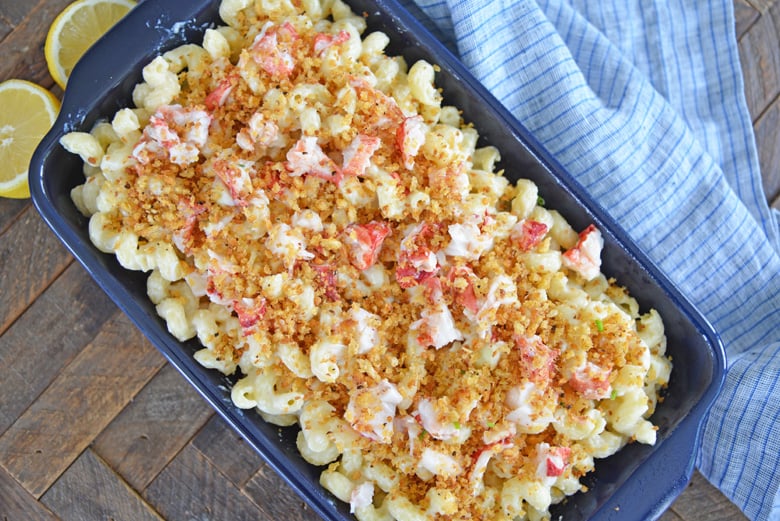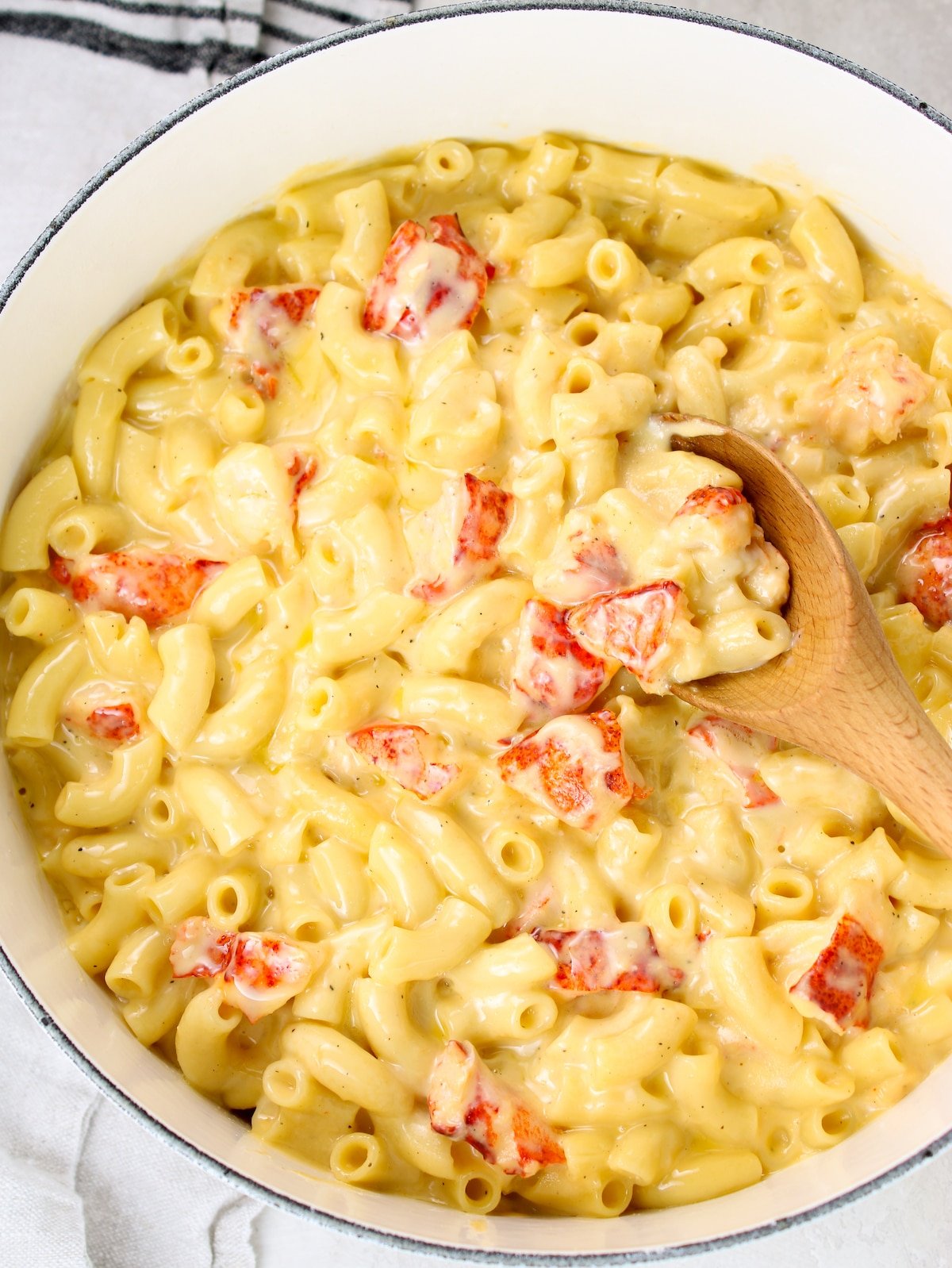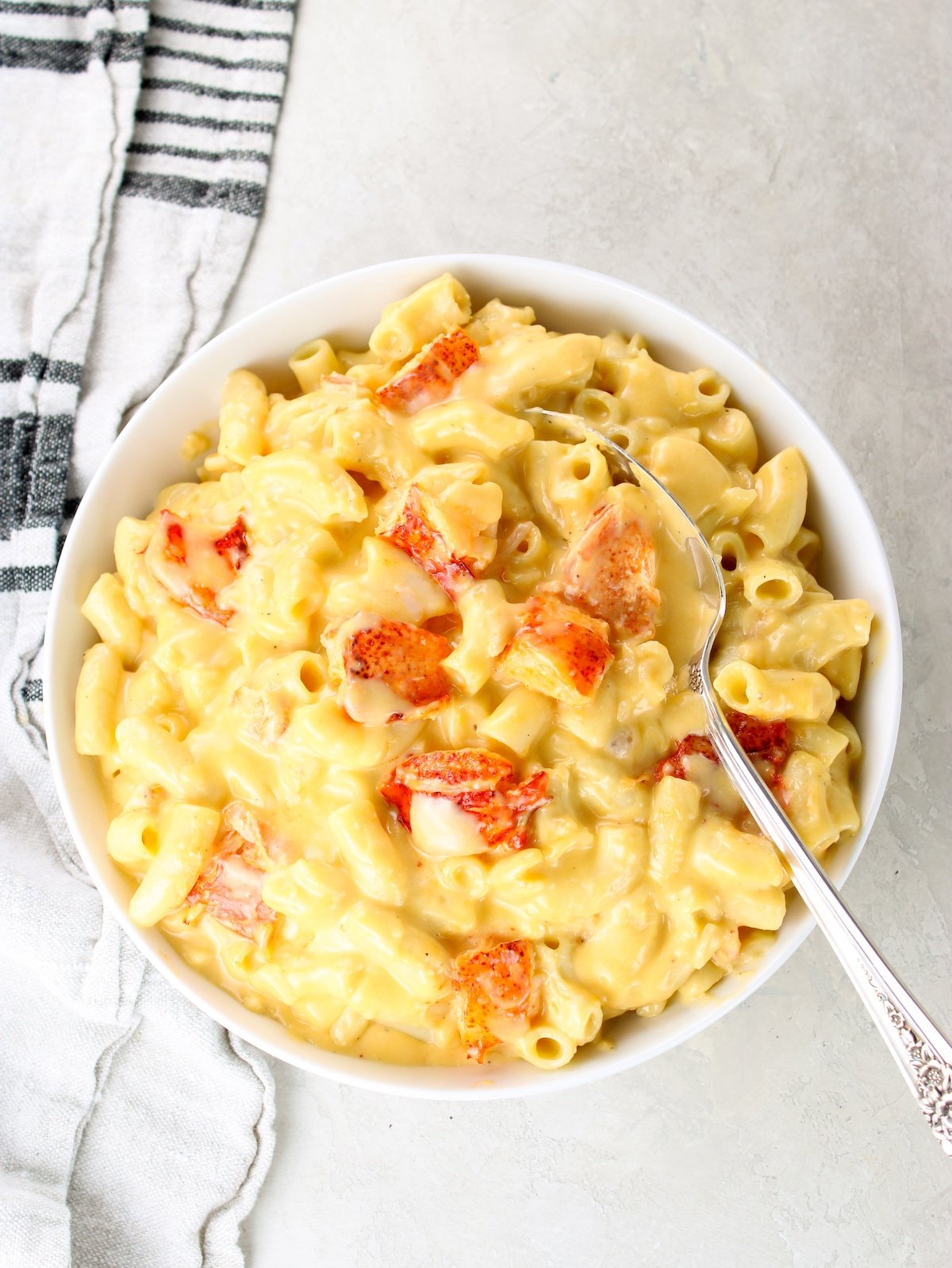These two comfort foods, lobster mac and cheese, are combined in one pot of creamy, cheesy goodness. This homemade lobster mac and cheese made on the stove melts in your mouth and is beyond delicious.
Recently I stopped by the grocery store to pick up a few things. And yes, 37 things later, I’m finally checking out. 35 of them, none of which I planned to buy, but I was hungry and wanted everything I saw.
For example, the store-made mac and cheese sitting in the prepackaged refrigerated food area. Looking all creamy with the perfect golden hue of cheddar cheesy yumminess. So into the cart that went with everything else.
I couldn’t wait to get home and devour it. It was all I could think about. There I am barely in the door opening the mac and cheese and eating it cold.
“Umm, wait, something is wrong,” I thought next, which was not what I expected. “It looks deceptively delicious, but it tastes like salted pasta—no creamy, savory cheese to be found.” And to add to the disappointment, there was an unpleasant gritty texture.
I was disheartened. Luckily I had also purchased the chicken tenders from the prepackaged food area and they were fantastic!.
Lobster mac and cheese is the ultimate indulgent comfort food. With tender chunks of lobster and creamy, cheesy pasta, it’s easy to go overboard when enjoying this decadent dish. But what happens when you have leftover lobster mac and cheese lingering in your fridge? As much as we may love lobster mac and cheese, no one wants to eat rubbery, dried out pasta and tough lobster.
The good news is that with the right reheating method, you can revive leftover lobster mac and cheese to be just as delicious as the original. We tested several different reheating techniques to determine the best way to reheat lobster mac and cheese without compromising taste or texture. Read on for our detailed guide to reheating lobster mac perfectly every time.
Why Proper Reheating is Crucial
Lobster mac and cheese contains a delicate balance of textures and flavors. The silky cheese sauce pairs beautifully with the tender lobster meat and al dente pasta. But lobster can become rubbery and the pasta soggy if you don’t reheat them properly. Mac and cheese also tends to dry out, making it tough and grainy.
The key is to reheat the dish gently and evenly. High heat can overcook the lobster while drying out the sauce. Microwaves often heat unevenly, resulting in hot spots that destroy the texture. Our testing revealed that the oven, stovetop, and microwave can all be effective reheating methods as long as you follow a few guidelines.
Reheating Lobster Mac and Cheese in the Oven
The oven allows you to reheat lobster mac and cheese gently and evenly without overcooking. Here are the steps we recommend when using the oven:
-
Preheat oven to 350°F
-
Place lobster mac and cheese in a casserole dish or oven-safe pan. Glass baking dishes work well.
-
Cover tightly with aluminum foil to prevent drying out.
-
Bake for 15-20 minutes until heated through. Check it periodically and stir gently once or twice during baking.
-
For added moisture, you can stir in 1-2 tbsp milk, cream, or chicken broth before baking.
-
For a browned, crispy top, remove foil during last 5 minutes of baking and switch oven to broil for 2-3 minutes if desired.
-
Let rest 5 minutes before serving.
The oven allows you to precisely control the temperature so the dish reheats evenly all the way through. The foil traps steam to keep the pasta tender. Adding extra liquid provides insurance against drying out.
Reheating on the Stovetop
You can also effectively reheat lobster mac and cheese on the stovetop:
-
Place lobster mac and cheese in a saucepan over medium-low heat.
-
Gradually stir in 2-3 tbsp milk, cream, broth, or water to prevent drying out.
-
Cover pan and heat for 8-10 minutes, stirring frequently, until heated through.
-
Remove lid during last 2 minutes if you want a slightly thickened sauce.
-
Add extra cheese on top for the last minute if desired.
-
Remove from heat and let rest 5 minutes before serving.
Be sure to use a low or medium-low temperature setting. High heat can overcook the lobster while the center stays cold. Frequent stirring distributes heat evenly. The liquid provides moisture and allows you to loosen up the sauce if needed.
Reheating in the Microwave
The microwave provides the quickest reheating option, but you need to use care to prevent rubbery lobster and dried out sauce. Follow these tips when microwaving lobster mac and cheese:
-
Place lobster mac and cheese in a microwave-safe dish. Glass baking dishes work well.
-
Cover dish tightly with plastic wrap to retain moisture.
-
Microwave on medium power in 1-minute intervals.
-
Stir between intervals to distribute heat evenly.
-
Microwave just until heated through, about 3-5 minutes total.
-
Allow to rest 2 minutes before serving.
The plastic wrap creates a steam environment that keeps the pasta tender. Frequent stirring prevents hot spots that can overcook sections. Short 1-minute bursts give you better control over timing. Allowing it to rest completes the cooking process gently.
Extra Tips for the Best Results
Following these simple tips will take your reheated lobster mac and cheese to the next level:
-
Stir in extra cheese like cheddar, gruyere, or fontina before reheating for more gooey, cheesy flavor.
-
Add cooked lobster meat or shrimp for extra richness and flavor.
-
Top with breadcrumbs or crushed crackers for crunchy texture. Broil for 2-3 minutes at the end for a crispy crust.
-
Finish off with chopped parsley, diced tomatoes, or lemon zest for a pop of color and freshness.
-
Drizzle with truffle oil or lobster bisque for luxury.
-
Make it more creamy and saucy by stirring in sour cream, heavy cream, or half-and-half.
-
Sprinkle with Old Bay seasoning or other seafood seasoning blends.
-
For fun presentations, reheat in lobster shells, small cast iron pans, or hollowed bread boules.
Storing Leftovers Properly
To get the most out of your leftover lobster mac and cheese, be sure to store it correctly after initial use:
-
Allow to cool completely, then transfer to an airtight container.
-
Glass storage containers work best. Avoid plastic bags or foil.
-
Press plastic wrap directly onto the surface to prevent a skin forming.
-
Refrigerate for up to 4 days. The flavors meld as it sits.
-
For longer storage, freeze leftovers for up to 3 months. Thaw overnight in fridge before reheating.
Proper storage retains moisture and ensures the best flavor. Lobster mac and cheese tastes even better the next day once the flavors fuse together. Frozen leftovers make for quick future meals.
Common Questions about Reheating Lobster Mac and Cheese
If you’re new to reheating lobster mac and cheese, here are answers to some common questions:
How do you keep the pasta from getting mushy?
- Use lower heat and stir gently to prevent overcooking.
- Cook just until heated through, not beyond.
- Add extra cheese and liquid to help emulsify and bind the sauce.
What if my sauce gets dry and grainy?
- Stir in extra liquid like milk, cream, or broth before and during reheating.
- Consider adding cheese or sour cream to emulsify and smooth it out.
- Add stovetop sauce ingredients like butter and flour to thicken and bind it.
What causes rubbery lobster meat?
- Overcooking with high heat. Reheat gently.
- Uneven heating that partially cooks the lobster. Stir and maintain low heat.
How can I revive a dried out lobster mac casserole?
- Place dish in a bath of hot water to moisten and loosen dried areas.
- Stir in liquid until it reaches the desired saucy consistency.
- Add cheese, sour cream, or cream sauce ingredients to emulsify and bind it.
What if my microwave leaves cold spots?
- Stir frequently and microwave in short intervals to distribute heat evenly.
- Cover dish tightly so steam heats all areas.
- Finish reheating on the stovetop or in the oven if needed.
Enjoy Your Leftovers!
There’s no reason to let leftover lobster mac and cheese go to waste. With the proper reheating techniques, you can enjoy every last tasty morsel. Now that you know how to reheat lobster mac and cheese perfectly, you can indulge without regret, confident that your leftovers will taste just as amazing the next day. Get creative with mix-ins and toppings to give your reheated dish an exciting new twist. Leftover lobster mac and cheese for the win!

Melt the Cheese on a Lower Temperature Setting:
It is also important to lower the heat before adding the cheeses so that the lobster macaroni and cheese has the smoothest texture. When you add cheese to a very hot liquid, the proteins can solidify, making the liquid lumpy or stringy, and the fat will separate, making a greasy mess.
While some cheeses can handle higher temperatures, it’s best to play it safe and add the cheese at the end of the cooking process. You want it to just barely reach its melting point – but not go much beyond it.
Tip: One more tip is to not over-stir when you’re incorporating the cheese. I like to use a whisk and gently stir the mixture as it melts. Over-stirring causes the proteins to clump and could create a stringy or lumpy texture.

Let’s get down to the details of creating this lobster macaroni and cheese recipe…
The Secret Ingredient for the Best Macaroni and Cheese is American Cheese!
You may be surprised but the secret to creamy non-gritty lobster mac and cheese is American cheese.
Yep – not kidding. My friends over at America’s Test Kitchen taught me this little trick. And now it’s the only way I make it.
To be honest: American cheese is not my favorite for most recipes. In fact, I think I only purchase it when I’m making macaroni and cheese.
It has its place, even though I’m not a big fan of it. And that place is right here in this delicious Lobster Macaroni and Cheese!
American cheese will ensure you end up with a silky, smooth cheese sauce. Here’s why… it’s all about the additives. While American cheese is full of stabilizers, it is these stabilizers that keep your cheese sauce from getting grainy.
To be clear, don’t use sliced American cheese from the dairy/cheese section of the store. That’s a different kind of cheese.
You need to ask for an 8-ounce piece of American cheese at the grocery store’s deli counter. They usually slice it thinly for sandwiches, etc. , but there’s no need to have them slice it since you’ll be chopping it into cubes.
So there you have it: American cheese makes things creamy, but not so much when it comes to taste.
So it needs to be paired with other savory strong flavored cheeses to incorporate more flavor. I recommend Cheddar, Parmesan, Gouda, smoked Gouda, Monterey Jack, Gruyere, and Fontina for Macaroni and Cheese.

There are a few other factors for keeping this recipe creamy, like…
It’s best to buy your cheese in a block or wedge and shred it yourself. So that it doesn’t stick together in the bag, most store-bought shredded cheese has an anti-caking cellulose agent added to it. And when its melted, that agent can cause the sauce to be grainy.
